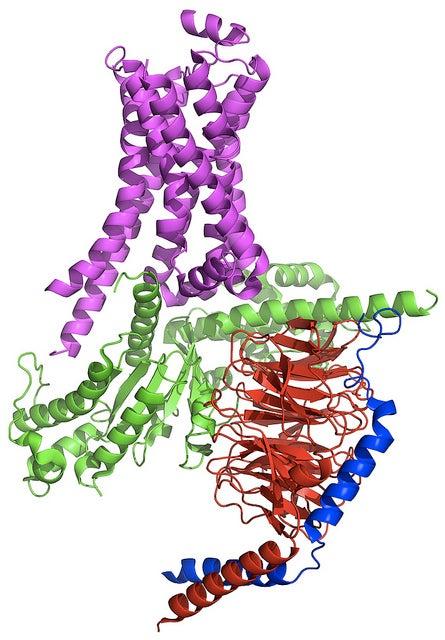Synchrotrons Play Role in Nobel Prize Research
Synchrotrons played a key role in the research that won Brian Kobilka, a professor and chair of Molecular and Cellular Physiology at the Stanford School of Medicine, the 2012 Nobel Prize in chemistry on Wednesday.
By Glenn Roberts Jr.
Synchrotrons played a key role in the research that won Brian Kobilka, a professor and chair of Molecular and Cellular Physiology at the Stanford School of Medicine, the 2012 Nobel Prize in chemistry on Wednesday.
Kobilka, who shares the Nobel with Robert Lefkowitz of Duke University, performed his prize-winning research mostly at the Argonne National Laboratory synchrotron. It revealed the structure and functioning of a protein complex on the surface of human cells, called a G-protein-coupled receptor, that receives signals from the cell’s environment and is a key target for drug development.
But he and his colleagues also used SLAC’s Stanford Synchrotron Radiation Lightsource (SSRL) in the mid 1990s and early 2000s to develop techniques for determining the structure of protein receptors.
Crystals and Microbeams
Researchers typically use a method called X-ray crystallography to discover a protein’s atomic structure. They crystallize the protein, then bombard it with X-ray light. The patterns made by light diffracting off atoms in the crystal reveal the protein’s structure.
However, the proteins in these cellular receptors, which sit in the fatty outer membranes of cells and regulate many important physiological processes, are extremely complex and fragile, and difficult and costly to crystallize.
William Weis, a longtime collaborator in Kobilka's work, is a member of the Photon Science faculty at SLAC and a professor of structural biology at Stanford University. He said, "Over the years, when we had some crystals, we would look at them at SSRL to see if we were making any progress at getting anything that diffracted," or successfully produced an image.
Because their crystallized samples were so small, it became clear, Weis said, that smaller-sized X-ray beams were required to provide higher-resolution imaging.
"The crystals really required microbeams – really finely focused X-ray beams," which were first available at the European Synchrotron Radiation Facility in Grenoble, France, Weis said: "If you use a larger beam, you get too much background. It's really a signal-to-noise problem."
After running experiments at the French facility, Weis and Kobilka began using similar microbeams at Argonne’s Advanced Photon Source (APS), a synchrotron X-ray research facility in Illinois. It was there, at APS, that most of the data related to the Nobel Prize-winning research was collected.
New Research Possibilities
Weis said future research related to the cellular receptors could also be conducted at the SSRL, which now offers a beamline with microbeams and in some tests has produced high-resolution images comparable to those from the microbeam at APS.
There is also potential to propose related experiments at SLAC's Linac Coherent Light Source X-ray laser facility, he said, which may allow researchers to outrun the problem of damaging fragile protein samples with radiation before they can be imaged. "One of the promises of LCLS is that we can do the so-called 'diffract before destroy' experiment," Weis said, gathering structural information in the quadrillionths of a second before the crystals are obliterated in the powerful X-ray laser pulses.
In fact, researchers have already conducted experiments at LCLS to better understand the structure of delicate membrane proteins, viruses and biological systems involved in photosynthesis, for example.
Weis said that when he learned about the Nobel Prize shortly after waking up Wednesday morning, "I thought it was great. I sent an email, obviously, to Brian. I can't say I was hugely surprised. These were such landmark studies."
In a media conference call on Wednesday, Kobilka said he hopes his research will ultimately lead to the development of more effective drugs to combat a wide range of diseases, from psychiatric disorders to diabetes, lung and heart diseases and cancer.
Early Crystallography Work at SSRL
He noted that while most of the data collection was at Argonne, the SSRL staff at SLAC "have been very generous with time" in his team's early efforts to produce useful diffraction images.
Those formative crystallography experiments began "in fits and starts," around 1995, Weis recalled, with occasional trips back and forth from Stanford to SLAC to test out diffraction on the latest batch of crystallized protein.
The ability to make crystallized samples of the receptors was in doubt when Kobilka began his work, Weis recalled: "People not that long ago, 10 years ago, were saying these things would never be crystallized."
He said it was Kobilka's "dedication and perseverance to the problem that brought everyone together. He brought whatever technology needed to be brought to bear on the problem."
Multidisciplinary Payoff
Kobilka said during a Wednesday press conference that he did not take failure as an answer when his research wasn't giving him the results he was seeking, noting the need for what a friend had described to him as "irrational optimism."
"Even though something fails, " he said, "you go home and at the end of the day, maybe you look down and then you think of an idea – 'Oh, this one's going to work' – and just keep thinking that something's going to work."
Kobilka also noted that his work has been "very much an interdisciplinary project," and that the proximity of the medical school to Stanford's other research groups has been fruitful.
"I remember early on I had some problem – I needed some chemistry expertise,” he said. “And I just walked to the chemistry department, started knocking on doors, asking, 'Do you know how to do this?' I came away with an answer."
